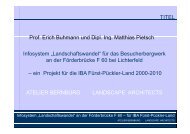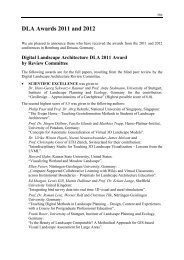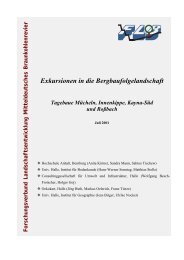GeoDesign Approach in Vital Landscapes Project
GeoDesign Approach in Vital Landscapes Project
GeoDesign Approach in Vital Landscapes Project
Create successful ePaper yourself
Turn your PDF publications into a flip-book with our unique Google optimized e-Paper software.
212<br />
S. Jombach, L. Kollányi, J. L. Molnár, Á. Szabó and T. D. Tóth<br />
application. Geodesign is hold as a comb<strong>in</strong>ed “toolset” of future world developers <strong>in</strong><br />
various fields from transport network planners to social science. Some th<strong>in</strong>k that geodesign<br />
is one form of decision mak<strong>in</strong>g (TOMLIN 2011), some considers as a convergence-program<br />
for bridg<strong>in</strong>g the gap between spatial analysis, and shap<strong>in</strong>g the future of spatial<br />
environments (SCHWARZ 2011). It is obvious that geodesign can <strong>in</strong>volve efforts to analyse,<br />
plan or <strong>in</strong>terpret alternative futures, describe landscape and its changes for stakeholders as<br />
many applications show (STEINITZ 2003, WOLF & MEYER 2010, LANGE & HEHL-LANGE<br />
2010). It has relevance to be used for plann<strong>in</strong>g of complex systems where geographical,<br />
visual and design aspects do matter. From our landscape architect’s po<strong>in</strong>t of view<br />
Geodesign is the comb<strong>in</strong>ation of software from GIS to CAD, that <strong>in</strong>tegrates materials from<br />
photographs to digital maps, believes the purpose of <strong>in</strong>form<strong>in</strong>g locals and planners, and<br />
supports the activities from plann<strong>in</strong>g to implementation. Some believe that geodesign is not<br />
a new enterprise for landscape architects (ERVIN 2011) as only the support<strong>in</strong>g tools were<br />
strengthened by new comput<strong>in</strong>g technology and deeply renewed its concept. Def<strong>in</strong>itely<br />
true. The task is to prove that we can analyse, assess and manage landscapes better and<br />
communicate this process more clever than without digital geodesign. Are we able to do it?<br />
2 Study Area<br />
Nagyberek Pilot Area <strong>in</strong> Southwest-Hungary used to be the largest swampy bay of Lake<br />
Balaton. This is one of the most transformed landscapes of Hungary with many<br />
contradictory characteristics. After the water regulations of the 19th century and the<br />
<strong>in</strong>tensive agricultural use <strong>in</strong> the middle of 20th century it still plays an important role <strong>in</strong> the<br />
ecological system of the largest lake <strong>in</strong> Central Europe. This dra<strong>in</strong>ed but still swampy<br />
region is mostly dom<strong>in</strong>ated by patches of forests, agricultural land, reeds, built up areas,<br />
network of channels and the <strong>in</strong>ternational highway l<strong>in</strong>e between Ljubljana and Budapest or<br />
generally between Italy and Russia. The area of about 300 km2 is represented by water<br />
management, forestry, hunt<strong>in</strong>g, fish<strong>in</strong>g activities, nature protection, extensive agriculture of<br />
pastur<strong>in</strong>g, viticulture, fruit and honey production, highway and railway l<strong>in</strong>es, traditional<br />
crafts, rural tourism and mass lakeshore tourism (Fig 1.).<br />
Due to the chang<strong>in</strong>g environmental circumstances, the disadvantageous economic<br />
tendencies and peripheral location <strong>in</strong> the Lake Balaton touristic area, Nagyberek is bankrupt<br />
and has tremendous conflicts at the moment. Increas<strong>in</strong>g unemployment, ag<strong>in</strong>g population,<br />
low level of <strong>in</strong>frastructure, opposition of nature protection, agriculture and forestry do all<br />
represent the site. Due to the poor soil quality and extreme water conditions agriculture has<br />
low productivity. The mass tourism at the Balaton lakeshore has very slight effect on local<br />
rural tourism of the whole area right now. Depopulation and ethnic conflicts make the<br />
situation even more difficult. Despite of dom<strong>in</strong>ant human <strong>in</strong>fluence and <strong>in</strong>tensive<br />
agricultural utilisation <strong>in</strong> the past, the area still has relevant natural and cultural values. It<br />
seems like the conflicts with nature conservation of “Fehérvíz” marshland do not strengthen<br />
rural tourism, but decrease the breakout options <strong>in</strong> agriculture and forestry. In few<br />
settlements only extensive agriculture, activities related to heritage and unique landscape<br />
features and traditional land use can be beneficial activities for a limited number of farmers.<br />
There is a debate whether any of these could mean breakout choice for the study area.





